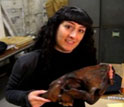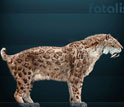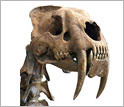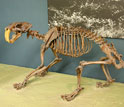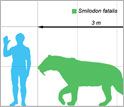News Release 12-002
Prehistoric Predators With Supersized Teeth Had Beefier Arm Bones
Combination of colossal canines and forceful forelimbs arose repeatedly over time
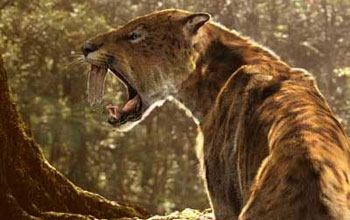
The extinct saber-toothed cat, among the largest cats ever to live, roamed North and South America.
January 4, 2012
View a video with paleontologist Julie Meachen of the NSF National Evolutionary Synthesis Center in Durham, North Carolina.
This material is available primarily for archival purposes. Telephone numbers or other contact information may be out of date; please see current contact information at media contacts.
The toothiest prehistoric predators also had beefier arm bones, according to results of a study published today in the journal Paleobiology.
Saber-toothed tigers may come to mind, but these extinct cats weren't the only animals with fearsome fangs.
Take the false saber-toothed cats--also known as nimravids--and their catlike cousins, a family of carnivores called the barbourofelids.
These mammal groups lived millions of years before cats came to be, and had knife-like canines along with well-built arm bones, said Julie Meachen, a paleontologist at the National Science Foundation (NSF) National Evolutionary Synthesis Center (NESCent) in Durham, North Carolina.
This killer combination arose repeatedly in different saber-toothed predators over time, presumably because it gave them an advantage when catching and killing prey, Meachen found.
"This is a nice demonstration that selection usually operates on suites of traits to generate solutions to environmental challenges," said Saran Twombly, program director in NSF's Directorate for Biological Sciences, which funds NESCent.
"In this case, the key to being an efficient predator integrated canines and forelimbs across different groups of felids and led to the development of different combinations of these traits," said Twombly. "It was the combination, rather than any single trait, that allowed a diverse group of organisms to thrive as predators."
The long, thin teeth of saber-toothed cats look formidable, but they're fragile compared with those of felines today.
"Cats now have canines that are short and round in cross-section, so they can withstand forces in all directions," Meachen said.
"That comes in handy for hunting--their teeth are better able to withstand the stress and strain of struggling prey without breaking."
In contrast, the elongated canines of saber-toothed cats were flattened side-to-side and were more oval, which made them more vulnerable to fracture.
In previous results published in 2010, Meachen reported that the saber-toothed cat Smilodon fatalis had exceptionally thick arm bones when compared with its feline cousins.
"Thick, robust bones are an indicator of forelimb strength," Meachen said.
The results suggest that these animals may have relied on their forelimbs to help catch and kill their prey without fracturing their fangs.
In studying the fossil skeletons of other saber-toothed predators, Meachen had a hunch that the combination of fragile knife-like canines and beefy arm bones might not have been unique to saber-toothed cats.
Earth was once home to a number of toothy carnivores that no longer roam the wilds.
Nimravids were meat-eaters that flourished for almost 35 million years, from about 42 to 7 million years ago, alongside another group of extinct predators, the barbourofelids, which lived from 17 to 9 million years ago, when they died out.
"If you saw one of these animals you'd probably think it was a cat, but true cats didn't evolve until millions of years later," Meachen said.
The animals left no living descendants, but thanks to fossilized bones scientists know that their upper canines came in a wide range of shapes and sizes.
Some species had canines that were short and round; others were long, flattened and more oval. Some were serrated "like a steak knife," Meachen said.
To find out if saber-toothed predators with longer, thinner teeth and delicate dentition generally had thicker forelimbs, Meachen measured the fossilized arm bones and upper canines of hundreds of museum specimens of extinct cats, nimravids and barbourofelids that once roamed North America.
She also measured the teeth and arm bones of 13 cat species living today--such as the tiger and the clouded leopard--all of which have conical teeth.
When she compared the dimensions of the teeth to those of the arms, she found that each group of animals gradually converged on the same solution--the longer the teeth, the thicker the forelimbs.
The results held up even after taking into account that larger species generally have bigger bones.
She attributes the striking similarities among the species to convergent evolution.
"The same correlated sets of traits arose repeatedly through time," Meachen said.
"It's hard to know which came first--long, fragile canines, or strong, robust forelimbs. It's sort of a chicken-and-egg question."
-NSF-
-
View Video
Paleontologist Julie Meachen talks about the teeth and limbs of saber-toothed cats.
Credit and Larger Version -
Saber-toothed cats had very thick arm bones compared with those of modern feline cousins.
Credit and Larger Version -
The skull of a saber-toothed cat shows its extremely long canine teeth.
Credit and Larger Version -
A saber-toothed cat still crouches: in a natural history museum.
Credit and Larger Version -
The outline of a saber-toothed cat, shown in comparison with that of a human.
Credit and Larger Version
Media Contacts
Cheryl Dybas, NSF, (703) 292-7734, email: cdybas@nsf.gov
Robin Ann Smith, NESCent, (919) 668-4544, email: rsmith@nescent.org
Related Websites
NSF National Evolutionary Synthesis Center: http://www.nescent.org/
The U.S. National Science Foundation propels the nation forward by advancing fundamental research in all fields of science and engineering. NSF supports research and people by providing facilities, instruments and funding to support their ingenuity and sustain the U.S. as a global leader in research and innovation. With a fiscal year 2023 budget of $9.5 billion, NSF funds reach all 50 states through grants to nearly 2,000 colleges, universities and institutions. Each year, NSF receives more than 40,000 competitive proposals and makes about 11,000 new awards. Those awards include support for cooperative research with industry, Arctic and Antarctic research and operations, and U.S. participation in international scientific efforts.
Connect with us online
NSF website: nsf.gov
NSF News: nsf.gov/news
For News Media: nsf.gov/news/newsroom
Statistics: nsf.gov/statistics/
Awards database: nsf.gov/awardsearch/
Follow us on social
Twitter: twitter.com/NSF
Facebook: facebook.com/US.NSF
Instagram: instagram.com/nsfgov



